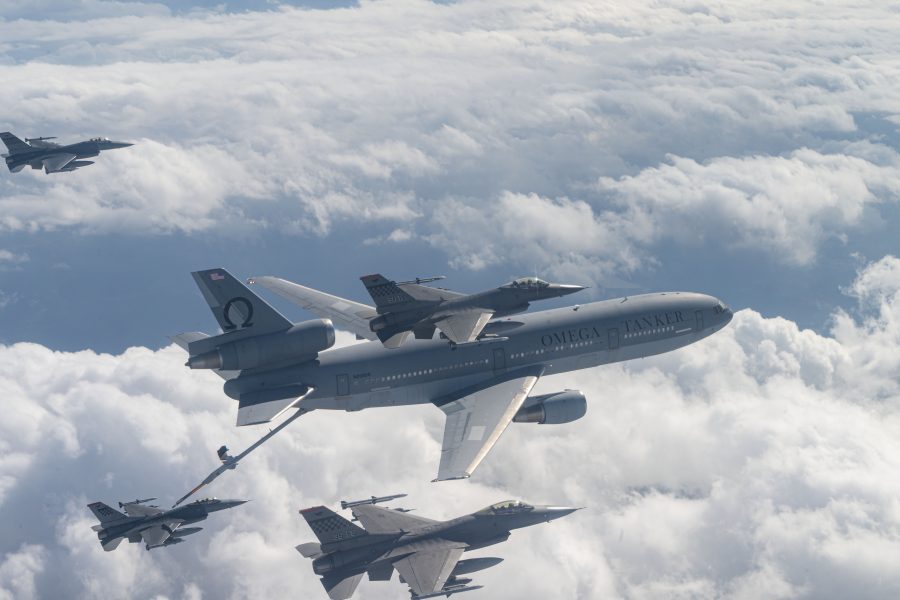Three types of U.S. Air Force fighter aircraft participated in air-to-air refueling with commercial tankers for the first time last month, coinciding with a bilateral exercise between the U.S. and Singapore that concluded Nov. 24.
‘Commando Sling’ began Nov. 6 and featured six F-16 Fighting Falcons from the 51st Fighter Wing at Osan Air Base, South Korea. On Nov. 9, Pacific Air Forces announced a commercial KDC-10 tanker refueled the F-16s en route to Singapore, with plans to also refuel F-15s and F-22s before the end of the exercise.
A PACAF spokesperson later confirmed to Air & Space Forces Magazine that commercial tankers refueled F-15C and F-22 fighters, though they declined to reveal the exact dates and locations.
The missions mark a milestone for the Air Force, which typically relies on its own tankers to keep its aircraft flying but has started to dip its toe into the commercial refueling world. In June, a commercial refueler linked up with E-3 Sentry and RC-135 Rivet Joint aircraft during during an exercise, the first ever instance for any U.S. Air Force aircraft.
“We’re expanding that aperture in PACAF and identified a proof-of-concept employment to refuel fighter aircraft during exercise Commando Sling 23.” PACAF air mobility operations chief Lt. Col. Curtis Holtman said in a Nov. 9 release.
The advantage of commercial refueling, Holtman said, is that “it frees up our warfighter tanker fleet to be ready to respond for emerging contingency requirements.”
The U.S. Navy and Marine Corps have used commercial refuelers for almost two decades, and there are several companies that offer the service. Metrea Strategic Mobility conducted the first refueling missions in July, while Omega Air Refueling provided the KDC-10 that refueled the F-16s.
The KDC-10 is designed for dual functionality, capable of refueling in flight and transporting cargo or passengers. During the exercise, the aircraft transported more than 40 personnel and cargo on a single flight. The KDC-10 is a close relative of the USAF’s largest air refueling aircraft, the KC-10 Extender, both derived from the McDonnell Douglas DC-10.
Also during Commando Sling, U.S. pilots engaged in combined tactics and dissimilar dogfighting involving practicing combat maneuvers against different aircraft. The combined forces focused on live flight support operations while covering fighter air-to-air capabilities such as airborne refueling.
“[We] trained with Singaporean F-15s [SG], F-16s [Block 52], and refueled multiple times with their A330 Multi-Role Tanker Transport,” said Lt. Col. Cory Ferrer, 36th Fighter Squadron commander, in a release.
Following the completion of the exercise, the six F-16s and around 90 Airmen, including the pilots from the 51st Fighter Wing, returned to Osan from Paya Lebar Air Base in Singapore.
“The training is invaluable in allowing them to learn how to better employ the F-16 against aircraft that have different performance characteristics and methods of fighting,” instructor pilot Capt. Jonathan Lee said about the training.
Since its inception in 1990, Exercise Commando Sling aims to bolster interoperability and joint capability between the two nations by practicing tactical coordination. Ferrer highlighted that exercises like this enable the squadron to refine combat agility, while demonstrating “the strength and necessity of partnerships.”
